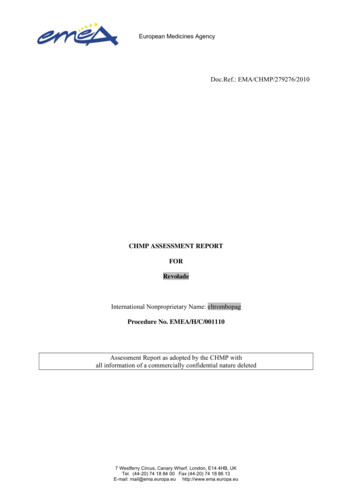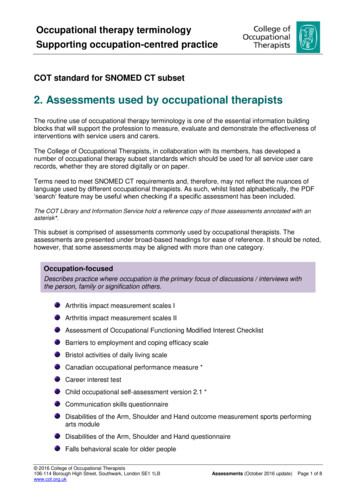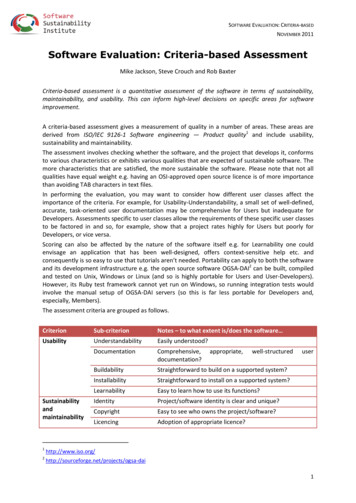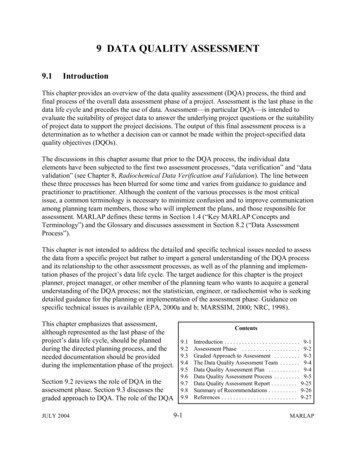
Transcription
European Medicines AgencyDoc.Ref.: EMA/CHMP/279276/2010CHMP ASSESSMENT REPORTFORRevoladeInternational Nonproprietary Name: eltrombopagProcedure No. EMEA/H/C/001110Assessment Report as adopted by the CHMP withall information of a commercially confidential nature deleted7 Westferry Circus, Canary Wharf, London, E14 4HB, UKTel. (44-20) 74 18 84 00 Fax (44-20) 74 18 86 13E-mail: mail@ema.europa.eu http://www.ema.europa.eu
TABLE OF CONTENTSPage1.BACKGROUND INFORMATION ON THE PROCEDURE .31.1Submission of the dossier . 31.2Steps taken for the assessment of the product. 42SCIENTIFIC DISCUSSION.52.1Introduction. 52.2Quality aspects . 62.3Non-clinical aspects . 82.4Clinical aspects . 202.5Pharmacovigilance. 722.6Overall conclusions, risk/benefit assessment and recommendation . 752/79
1.BACKGROUND INFORMATION ON THE PROCEDURE1.1Submission of the dossierThe applicant GlaxoSmithKline Trading Services Ltd. submitted on 04 December 2008 anapplication for Marketing Authorisation to the European Medicines Agency (EMEA) through thecentralised procedure for Revolade, which was designated as an orphan medicinal productEU/3/07/467 on 03 August 2007. Revolade was designated as an orphan medicinal product in thefollowing indication: treatment of idiopathic thrombocytopenic purpura. The calculated prevalenceof this condition was between 1 and 4 in 10,000 persons in the European Union, which, at the time ofdesignation, corresponded to between about 50,000 and 199,000 persons.The applicant applied for the following indication: treatment of previously treated patients withchronic idiopathic thrombocytopenic purpura (ITP) to increase platelet counts and reduce or preventbleeding.The legal basis for this application refers to:Article 8.3 of Directive 2001/83/EC, as amended - complete and independent applicationInformation on Paediatric requirementsPursuant to Article 7 of Regulation (EC) No 1901/2006, the application included an EMEA DecisionP/207/2009 for the following condition: Idiopathic thrombocytopenic purpura (ITP)on the agreement of a paediatric investigation plan (PIP).The PIP is not yet completed.Information relating to Orphan Market ExclusivitySimilarityPursuant to Article 8 of Regulation (EC) No. 141/2000 and Article 3 of Commission Regulation(EC) No 847/2000, the application contained a critical report addressing the possible similarity withauthorised orphan medicinal products.Protocol Assistance:The applicant received Protocol Assistance from the CHMP on 24 March 2006. The ProtocolAssistance pertained to clinical aspects of the dossier.Licensing status:Revolade has been given a Marketing Authorisation in the United States of America on 20November 2008 (US tradename Promacta).The Rapporteur and Co-Rapporteur appointed by the CHMP were:Rapporteur:Gonzalo Calvo RojasCo-Rapporteur: Ian Hudson3/79
1.2 Steps taken for the assessment of the productThe application was received by the EMEA on 04 December 2008.The procedure started on 24 December 2008.The Rapporteur's first Assessment Report was circulated to all CHMP members on 30 March2009. The Co-Rapporteur's first Assessment Report was circulated to all CHMP members on17 March 2009.During the meeting on 20-23 April 2009 the CHMP agreed on the consolidated List ofQuestions to be sent to the applicant. The final consolidated List of Questions was sent to theapplicant on 23 April 2009.The applicant submitted the responses to the CHMP consolidated List of Questions on 22 May2009.The Rapporteurs circulated the Joint Assessment Report on the applicant’s responses to theList of Questions to all CHMP members on 8 July 2009.During the CHMP meeting on 20-23 July 2009, the CHMP agreed on the first List ofOutstanding issues to be addressed in writing by the applicant.The applicant submitted the responses to the First CHMP List of Outstanding Issues on 24August 2009.The Rapporteurs circulated the Joint Assessment Report on the applicant’s responses to thefirst List of Outstanding Issues to all CHMP members on 10 September 2009.During the CHMP meeting on 21-24 September 2009, the CHMP agreed on the second list ofoutstanding issues to be addressed in writing by the applicant.The applicant submitted the responses to the CHMP second List of Outstanding Issues on 02October 2009.The Rapporteurs circulated the Joint Assessment Report on the applicant’s responses to thesecond List of Outstanding Issues to all CHMP members on 07 October 2009.During the CHMP meeting on 19-22 October 2009, the CHMP agreed on the third list ofoutstanding issues to be addressed in writing by the applicant.The applicant submitted the responses to the CHMP third List of Outstanding Issues on 16November 2009.During a meeting of an Expert group on 01 December 2009, experts were convened to addressquestions raised by the CHMP.The Rapporteurs circulated the Joint Assessment Report on the applicant’s responses to thethird List of Outstanding Issues to all CHMP members on 02 December 2009.During the meeting on 14-17 December 2009, the CHMP, in the light of the overall datasubmitted and the scientific discussion within the Committee, issued a positive opinion forgranting a Marketing Authorisation to Revolade on 17 December 2009. The applicantprovided the letter of undertaking on the follow-up measures to be fulfilled post-authorisationon 15 December 2009.The CHMP adopted a report on similarity of Revolade with Nplate on 25 June 2009.The CHMP opinions were forwarded in all official languages of the European Union, to theEuropean Commission, which adopted the corresponding Decision on 11 March 2010.4/79
2SCIENTIFIC DISCUSSION2.1 IntroductionChronic idiopathic thrombocytopenic purpura (ITP) is an autoimmune disorder characterized byautoantibody-induced platelet destruction and reduced platelet production, leading to a lowperipheral blood platelet count ( 150,000/μL). The epidemiology of ITP shows an overall incidenceof ITP among adults from 1.6 to 3.0 per 100,000 person years of observation. Prevalence estimatesrange from 2.1 to approximately 36.4 per 100,000 persons. The estimated adult prevalence is 24.6per 100,000 persons.The exact aetiology of ITP is unknown and the diagnosis of ITP remains one of exclusion. Theclinical hallmark of the disease is an increased, pathological tendency to bleed, spontaneously orafter minimal trauma. Routine diagnostic tools are blood count, peripheral blood film, patienthistory, physical examination and prompt response to high-dose corticosteroidsDisease management decisions in patients with chronic ITP are based primarily on platelet count andseverity of bleeding. The goal of treatment is to elevate platelet counts to a safe range ( 50,000/μL to250,000/μL) to minimise the risk of bleeding. Medical treatment to elevate platelet counts to a saferange is recommended if patients’ platelet count is below 30,000/μL or if bleeding symptoms arepresent.Currently immunoglobulins (anti-D and IVIg) are used for the treatment of ITP. Additional drugs totreat chronic ITP include corticosteroids, azathioprine, cyclophosphamide, or vincristine. Based onthe literature, first-line treatment with intravenous immunoglobulins or corticosteroids results innormal or sufficient platelet counts in about 70% of patients with chronic ITP. IVIg typicallyprovides a temporary elevation of platelet counts within up to 5 days and for an average duration of3-4 weeks. Corticosteroids will induce a response within up to two weeks, although the effect isoften not sustained upon dose reduction or cessation of treatment, and long-term administration ofcorticosteroids is limited by the development of side effects. Furthermore, corticosteroid-treatedpatients are at increased risk of infections. Second-line therapy typically involves splenectomy. Twothirds of patients with ITP who undergo splenectomy will achieve a normal platelet count, which isoften sustained with no additional therapy. Patients who do not have a complete response can stillexpect some improvement in platelet counts (e.g. partial response) or transient increases in plateletcount. When adult patients fail to first and second line therapies, they are considered as chronicrefractory ITP. The actual percentage of patients defined as having refractory ITP varies from 11%to 35%. Romiplostim (Nplate), a recombinant protein that increases platelet production throughactivation of the thrombopoietin receptor (TPO-R), was authorised in the EU in February 2009.This application seeks marketing authorization for Revolade (eltrombopag) as a centralisedprocedure according to (EC) No 726/2004, Mandatory scope (Article 3(1)), Annex (4) Orphandesignated medicinal product. Eltrombopag received an orphan medicinal product designation in theEuropean Union on 03 August 2007 for the treatment of chronic ITP (Community Register ofOMP s EU/3/07/467).The claimed therapeutic indication is:‘Revolade is indicated for the treatment of previously treated patients with chronic idiopathicthrombocytopenic purpura (ITP) to increase platelet counts and reduce or prevent bleeding.’The approved therapeutic indication is:5/79
“Revolade is indicated for adult chronic immune (idiopathic) thrombocytopenic purpura (ITP)splenectomised patients who are refractory to other treatments (e.g. corticosteroids,immunoglobulins). Revolade may be considered as second line treatment for adultnon-splenectomised patients where surgery is contraindicated”.A Paediatric Investigation Plan (PIP) for the condition idiopathic thrombocytopenic purpura (ITP)has been agreed by the PDCO. The subset of the paediatric population concerned by the paediatricdevelopment included children from 1 year to less than 18 years. Newborns and infants from birth toless than 1 year have been waived on the grounds that ITP does not occur in this paediatric subset.The paediatric plan included the development of new a powder formulation for oral suspension infixed single-dose sachets and a clinical study to investigate the safety, tolerability and efficacy ofeltrombopag in patients diagnosed with ITP from 1 year to less than 18 years old. A deferral hasbeen granted for completion of the quality study and for the initiation and completion of the clinicalstudy.Revolade is a small molecule for oral administration that increases platelet production throughactivation of the TPO-R. The recommended initial dose for eltrombopag is 50 mg once dailyadministered orally. If after 2 to 3 weeks of initial therapy, the platelet counts are below the clinicallyindicated levels (e.g. 50,000/μL); the dose may be increased to a maximum of 75 mg once daily. Adose reduction is recommended for patients with platelet counts between 150,000 and 250,000/μL.Once the platelet count is 100,000/μL, therapy should be reinitiated at a reduced daily dose.Eltrombopag treatment should only be initiated by a physician experienced in the treatment ofthrombocytopenia. The diagnosis of ITP in adults and elderly patients should have been confirmedby the exclusion of other clinical entities presenting with thrombocytopenia. Consideration should begiven to performing a bone marrow aspirate and biopsy over the course of the disease and treatment,particularly in patients over 60 years of age, those with systemic symptoms or abnormal signs.2.2 Quality aspectsIntroductionRevolade is presented in the form of film-coated tablets containing 31.9 mg or 63.8 mg ofeltrombopag olamine equivalent to 25 mg or 50 mg of eltrombopag respectively. The tablets arepackaged in blisters composed of polyamide / aluminium foil / polyvinyl chloride (PVC) laminatesealed with aluminium foil lidding with a vinyl acrylic seal coating.Other excipients in the product are listed in Section 6.1 of the SPC.Active SubstanceEltrombopag is an orally bioavailable, small molecule TPO-R agonist present in the form of the bismonoethanolamine (olamine) salt.It is a crystalline solid, red/brown, sparingly soluble in water. The molecule does not containasymmetric centres although it exists as the6/79
Z - conformer in the solid state. It is thermally stable up to about 125 C. One solid state form (Form1), is consistently obtained by the synthetic process described, and this is the form that appears in theproduct. The active substance is milled to produce a consistent particle size distribution. ManufactureThe manufacturing process is correctly described, and specifications for reagents, solvents andauxiliary materials used in the process are satisfactory. All critical in-process controls parameters arewell established and justified. The isolated intermediate is controlled by well described and validatedmethods. A single route of synthesis has been used throughout the chemical development ofeltrombopag olamine. Based on knowledge gained during development of the process, together withtools such as a Parameter Attribute Matrix (PAM) and FMEA risk assessment, the processparameters most likely to have the greatest impact on API quality have been identified.The chemical structure is well characterised by the usual range of spectroscopic and physicochemicalstudies. All relevant characteristics of this substance have been studied and established.Concerning the impurities likely to arise during the synthesis, a reasoned discussion has beenprovided according to ICH Q3A (R2) Guideline, including their origin according to themanufacturing process described and the main degradation pathways. SpecificationIn general, the specification proposed is suitable to control the quality of the drug substance. Inaddition to the potential impurities, those impurities routinely found to arise during the synthesis ofthe active substance have been identified and controlled using validated methodology. Furthermore,the specified limits have been justified with reference to toxicology studies. Results of over 30batches used in clinical, non-clinical and stability studies were provided during the evaluation phaseand all recent batches at the intended commercial scale complied with the agreed specification. StabilityThe drug substance is stored in HDPE containers lined with anti-static LDPE bags and sealed withplastic ties. The main degradation pathways of eltrombopag olamine have been defined.The stability studies and conditions are in agreement with ICH Q1A Guideline and the testsperformed are considered stability indicating. Based on the accumulated stability data so far, asuitable and practical retest period has been defined.Medicinal ProductThe tablets have been formulated to contain the following excipients: Microcrystalline cellulose,mannitol, povidone K-30, sodium starch glycolate, magnesium stearate and Opadry White YS-17706-G or Opadry Brown 03B26716. The Opadry White film coat consists of hypromellose,macrogol 400, polysorbate 80 and titanium dioxide (E171). The Opadry Brown film coat consists ofhypromellose, macrogol 400, titanium dioxide (E171), Iron oxide Yellow (E-172) and Iron oxideRed (E-172). The excipients and packaging are usual for this type of dosage form. Pharmaceutical DevelopmentThe pharmaceutical development of the product has been adequately performed and the choice ofexcipients is justified and their functions explained. Appropriate multivariate experimental planswere designed based on the prior knowledge and the risk analysis. Based on the multivariate designof experiments, a design space for the manufacturing process parameters has been defined. Theprocess inputs and the Critical Quality attributes are clearly defined in the design space. The choiceof the packaging is justified. The composition of the batches used for clinical studies are similar tothe final drug product.7/79
Manufacture of the ProductThe manufacturing process covers dry mixing of ingredients, granulation, wet milling, drying,milling blending (pre-lubrication and lubrication), compression, coating and packaging. Amanufacturing process flow diagram and a description of the manufacturing operations areprovided. There is evidence of a significant level of manufacturing experience obtained duringdevelopment, scale-up, and production of clinical supplies. Product SpecificationThe product specifications cover appropriate parameters for this dosage form and include specificreferences to PhEur where applicable. The analytical methods have been adequately described andvalidated. The analytical methods used are a combination of traditional methods and methodsdeveloped using Quality by Design (QbD) principles. Batch analytical data from the proposedproduction site have been provided, demonstrating compliance with the release specifications. Stability of the ProductResults of long-term and accelerated primary stability studies when stored at 30 C/65% RH or40 C/75% RH, respectively, have been provided. At submission, twenty-four months’ data wereprovided for these batches stored under long term condition, and 6 months’ data provided for thebatches stored under accelerated condition. All results from both primary stability and supportivestability batches comply with the limits and no significant changes and trend were observed in all thetested parameters. , generated from market image packs or supporting data from other presentations.Forced degradation studies and photostability studies have also been carried out.Discussion on chemical, pharmaceutical and biological aspectsThe pharmaceutical development of this sparingly-soluble drug product has been performed in asatisfactory way. Attention has focussed on the physical state of the active substance, in particularthe particle size, in order to obtain consistent bioavailability. A risk-based approach is applied to thedevelopment of the active substance (in the synthesis process of eltrombopag free acid and thesynthesis of eltrombopag olamine) in order to establish the design space and control strategy for theprocess parameters. Concerning pharmaceutical development of the product, the design intent was todevelop an oral formulation, with a minimal number of tablets per dose. A risk based approach(FMEA and BRITEST) was utilised during development, to identify and mitigate risks by dosageform design, the manufacturing process and controls where appropriate.Therefore the synthesis of the active substance and the manufacture of the product are under controland can deliver a consistently high quality active substance or product, controlled from batch tobatch by relevant and validated test methodology and specification limits.2.3 Non-clinical aspectsIntroductionA range of in vitro and in vivo studies have been conducted to investigate the primary and secondarypharmacology of eltrombopag, including a battery of safety pharmacology studies. Absorption,distribution, metabolism and excretion studies have been performed with eltrombopag to assess thesuitability of the animal species used during toxicological evaluation.As claimed by the applicant, all safety pharmacology studies, a number of pharmacokinetic studiesand all pivotal toxicity studies (including the toxicokinetic investigat
Protocol Assistance: The applicant received Protocol Assistance from the CHMP on 24 March 2006. The Protocol Assistance pertained to clinical aspects of the dossier. Licensing status: Revolade has been given a Marketing Authorisation in the United States of America on 2










